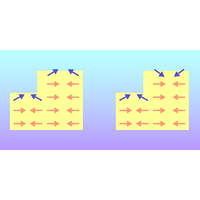Surface Magnetization in Antiferromagnets: Classification, Example Materials, and Relation to Magnetoelectric Responses
IF 11.6
1区 物理与天体物理
Q1 PHYSICS, MULTIDISCIPLINARY
引用次数: 0
Abstract
We use symmetry analysis and density-functional theory to determine and characterize surface terminations that have a finite equilibrium magnetization density in antiferromagnetic materials. A nonzero magnetic dipole moment per unit area or “surface magnetization” can arise on particular surfaces of many antiferromagnets due to the bulk magnetic symmetries. Such surface magnetization underlies intriguing physical phenomena like interfacial magnetic coupling and can be used as a readout method of antiferromagnetic domains. However, a universal description of antiferromagnetic surface magnetization is lacking. We first introduce a classification system based on whether the surface magnetization is either sensitive or robust to roughness and on whether the magnetic dipoles at surface of interest are compensated or uncompensated when the bulk magnetic order is retained at the surface. We show that roughness-sensitive categories can be identified by a simple extension of a previously established group-theory formalism for identifying roughness-robust surface magnetization. We then map the group-theory method of identifying surface magnetization to a novel description in terms of bulk magnetic multipoles, which are already established as symmetry indicators for bulk magnetoelectric responses at both linear and higher orders. We use density-functional calculations to illustrate that nominally compensated surfaces in magnetoelectric and centrosymmetric altermagnetic develop a finite magnetization density at the surface, in agreement with our predictions based on both group theory and the ordering of the bulk multipoles. Our analysis provides a comprehensive basis for understanding the surface magnetic properties and their intimate correspondence to bulk magnetoelectric effects in antiferromagnets and has important implications for technologically relevant phenomena such as exchange-bias coupling.

反铁磁体的表面磁化:分类、示例材料以及与磁电反应的关系
我们利用对称性分析和密度泛函理论来确定和描述反铁磁材料中具有有限平衡磁化密度的表面终端。由于体磁对称性,许多反铁磁体的特定表面会出现单位面积非零磁偶极矩或 "表面磁化"。这种表面磁化是界面磁耦合等有趣物理现象的基础,可用作反铁磁域的读出方法。然而,目前还缺乏对反铁磁性表面磁化的通用描述。我们首先介绍了一种分类系统,它基于表面磁化对粗糙度是敏感还是稳健,以及在表面保留体磁序时,相关表面的磁偶极子是得到补偿还是未得到补偿。我们的研究表明,粗糙度敏感类别可以通过对之前建立的群论形式主义的简单扩展来识别粗糙度稳健表面磁化。然后,我们将识别表面磁化的群论方法映射到用体磁多极子进行的新描述中,而体磁多极子已被确立为线性和高阶体磁电响应的对称指标。我们使用密度函数计算来说明,磁电 Cr2O3 和中心对称变磁 FeF2 中的名义补偿表面会在表面形成有限的磁化密度,这与我们基于群论和体磁性多极子排序的预测一致。我们的分析为理解反铁磁体的表面磁特性及其与块体磁电效应的密切对应关系提供了全面的基础,并对交换偏置耦合等技术相关现象具有重要意义。
本文章由计算机程序翻译,如有差异,请以英文原文为准。
求助全文
约1分钟内获得全文
求助全文
来源期刊

Physical Review X
PHYSICS, MULTIDISCIPLINARY-
CiteScore
24.60
自引率
1.60%
发文量
197
审稿时长
3 months
期刊介绍:
Physical Review X (PRX) stands as an exclusively online, fully open-access journal, emphasizing innovation, quality, and enduring impact in the scientific content it disseminates. Devoted to showcasing a curated selection of papers from pure, applied, and interdisciplinary physics, PRX aims to feature work with the potential to shape current and future research while leaving a lasting and profound impact in their respective fields. Encompassing the entire spectrum of physics subject areas, PRX places a special focus on groundbreaking interdisciplinary research with broad-reaching influence.
 求助内容:
求助内容: 应助结果提醒方式:
应助结果提醒方式:


